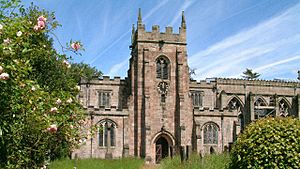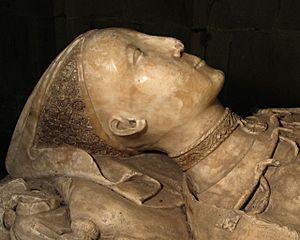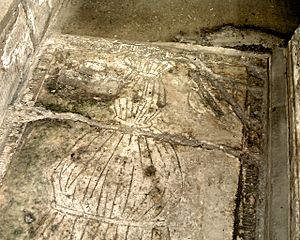St Mary and St Barlock's Church, Norbury facts for kids
Quick facts for kids St Mary and St Barlock’s Church, Norbury |
|
|---|---|

St Mary and St Barlock’s Church, Norbury
|
|
| 52°58′40.44″N 1°48′55.04″W / 52.9779000°N 1.8152889°W | |
| OS grid reference | SK 12549 42395 |
| Location | Norbury, Derbyshire |
| Country | England |
| Denomination | Church of England |
| History | |
| Dedication | St Mary and St Barlacus |
| Architecture | |
| Heritage designation | Grade I listed |
| Specifications | |
| Length | 95.5 feet (29.1 m) |
| Administration | |
| Parish | Norbury |
| Deanery | Ashbourne |
| Archdeaconry | Derby |
| Diocese | Derby |
| Province | Canterbury |
St Mary and St Barlock's Church is a very old parish church in Norbury, Derbyshire, England. It is a Grade I listed building, which means it is considered a very important historic site that must be protected.
Contents
The History of the Church
The church you see today is actually the third one built on this spot. The first was an Anglo-Saxon church, followed by a Norman church built around the year 1179.
The current church was built in stages over 200 years. This means different parts were added at different times, making it a fascinating mix of styles.
Who was Saint Barlock?
The church is dedicated to Saint Mary and Saint Barlock. Saint Barlock is believed to be another name for Saint Finbarr, an Irish saint from the 7th century.
The person who built the second church, John Fitzherbert, was once the governor of Waterford in Ireland. This connection to Ireland is likely why he chose to dedicate the church to an Irish saint. A stained-glass window in the church shows Saint Barlock holding a staff and a book.
Building the Church Piece by Piece
The oldest part of the current church is the chancel, which is the area around the altar. It was built around 1300. It's unusually large, even wider and taller than the main part of the church, called the nave.
The south tower, nave, and several chapels were added in the 1400s and early 1500s by the powerful Fitzherbert family, who were lords of Norbury. They also paid for beautiful stained-glass windows, many of which can still be seen today.
Restoring the Church
Like many old buildings, the church needed repairs over the centuries. It was restored in 1841, when old box-style pews were replaced with the open benches you might see in churches today.
Another major restoration happened between 1899 and 1900. This work was done by the architects Naylor and Sale from the nearby city of Derby.
Amazing Tombs of the Fitzherbert Family
The church is famous for its memorials to the Fitzherbert family. These tombs, or effigies, are like life-sized sculptures of the people buried there.
Knights in Armour
- Sir Henry Fitzherbert (died around 1315): His effigy shows him as a knight with his legs crossed. In the past, people thought this meant he was a Crusader, but historians now believe it was just a popular style for knightly tombs.
- Nicholas Fitzherbert (died 1473): He was the High Sheriff of Derbyshire. His tomb shows him in full plate armour, wearing a special collar of suns and roses. This collar was a badge showing his support for King Edward IV.
- Sir Ralph Fitzherbert (died 1483): His tomb is also very detailed. He wears a collar of suns and roses, but his has a pendant of a white boar. This was the symbol of King Richard III. Next to his feet is a tiny figure of a bedesman, a person paid to pray for the souls of the dead.
The armour shown on Sir Ralph's tomb was so detailed and accurate that a real, wearable suit of armour has been made based on its design.
A Sad Story in Stone
One of the most unusual tombs is for a woman named Benedicta Fitzherbert, who died in 1531. Her effigy is a flat slab of alabaster showing a figure wrapped in a burial shroud, or cloth.
Benedicta was married to John Fitzherbert. Their marriage was unhappy, and they lived apart. In his will, John was very unkind about Benedicta and left her and her children out of his inheritance. Her shrouded tomb might reflect the sadness of her story.
Church Features
The church has many interesting features for visitors to see.
The Lost Window
The great east window of one chapel once had amazing 14th-century stained glass. By the 1770s, the glass was in bad shape. To avoid the cost of repairing it, the church rector had the window bricked up, leaving the glass hidden inside the wall.
By 1842, the window was opened up again, but the original glass was gone. No one is sure if it was sold, stolen, or had simply crumbled away. The window was then filled with other 15th-century glass taken from different parts of the church.
Organ and Bells
The church has a pipe organ built in 1890 by a famous organ builder named Charles Lloyd. In the tower, there are three bells. The oldest was made around the year 1500, another was made in 1589, and the newest one is from 1739.
The Church Today
St Mary and St Barlock's is part of a joint parish, sharing its duties with St Peter's Church, Snelston. It remains an active and important part of the community.
See also
- Grade I listed churches in Derbyshire
- Grade I listed buildings in Derbyshire
- Listed buildings in Norbury and Roston





